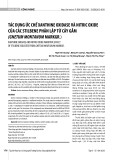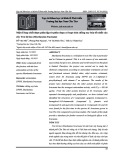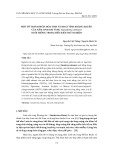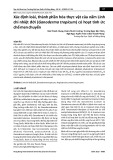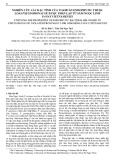
30 Nong Lam University, Ho Chi Minh City
The Journal of Agriculture and Development 23(Special issue 1) www.jad.hcmuaf.edu.vn
Effects of indole-3-butyric acid and 1-naphthaleneacetic acid on in vitro rooting and the
substrate mixing ratio on growth during the nursery stage of Mai vang (Ochna integerrima)
HD01 line
Kiet C. Nguyen*, Duy M. Pham, Van H. Phan, Tri M. Bui, & Le T. Hau
Faculty of Agronomy, Nong Lam University, Ho Chi Minh City, Vietnam
ARTICLE INFO ABSTRACT
Research Paper
Received: August 09, 2024
Revised: September 20, 2024
Accepted: September 27, 2024
Keywords
In vitro
Mai vang HD01
Nursery stage
Ochna integerrima
Plant growth regulator
*Corresponding author
Nguyen Cao Kiet
Email:
kiet.nguyencao@hcmuaf.edu.vn
Identifying suitable plant growth regulators for the rooting stage
and substrate mixing ratio for seedlings in the nursery remains a
significant challenge, particularly in relation to Mai vang. This plant
existed in culture and tradition for a long time and was considered
a symbol of the traditional Tet. The experiments were conducted
on Mai vang HD01 line, which was selected from Huu Duc Mai
garden in Binh Loi apricot village, known for its exceptional
characteristics. The objective of this study was to determine the
optimal Indole-3-butyric acid (IBA) and 1-naphthaleneacetic acid
(NAA) concentrations appropriate for root formation from shoot
samples in in vitro condition and the optimal substrate mixing
ratio appropriate for the growth of Mai vang HD01 line during the
nursery stage. The study including two experiments were arranged
in completely randomized design with one-factor and two-factor.
For rooting induction, the culture medium supplemented with
concentrations of IBA combined with concentrations of NAA
was used, while to grow, Mai vang HD01 plants were planted in a
substrate of coconut fiber, sand, rice husk ash, and vermicompost
with different mixing ratios. The results showed that Mai vang
HD01 shoots were cultured on Murashige and Skoog medium
supplemented with 0.5 mg/L IBA combined with 2 mg/L NAA
suitable for rooting and creating complete plants. The number
of roots, root length, plant height and number of leaves were 6.9
roots; 3.5 cm; 2.3 cm and 5.9 leaves, respectively on day 60. Mai
vang HD01 plants in the nursery stage were suitable for planting
on a substrate with a mixing ratio of 1 coconut fiber:1 sand:1 rice
husk ash:1 vermicompost with a 100% survival rate. They grew
quickly to a height of 5.1 cm which was higher than that of plants
planted on other substrate mix ratios on day 40.
Cited as: Nguyen, K. C., Pham, D. M., Phan, V. H., Bui, T. M., & Hau, L. T. (2024). Effects of indole-
3-butyric acid and 1-naphthaleneacetic acid on in vitro rooting and the substrate mixing ratio
on growth during the nursery stage of Mai vang (Ochna integerrima) HD01 line. The Journal of
Agriculture and Development 23(Special issue 1), 30-43.

Nong Lam University, Ho Chi Minh City 31
The Journal of Agriculture and Development 23(Special issue 1) www.jad.hcmuaf.edu.vn
which were known to grow well and have a
high survival rate (Huynh, 2007; Phan et al.,
2017). Therefore, in this study, we focused on
studying the most suitable combination to form
roots from Mai vang HD01 shoots and the most
suitable substrate mixing ratio for growing plants
in the nursery stage.
2. Materials and Methods
2.1. Time and place of the study
The study was carried out from July to
October 2023, at the tissue culture lab and the
plant nursery of the Department of Physiology
and Biochemistry, Faculty of Agronomy, Nong
Lam University, Ho Chi Minh City, Vietnam.
2.2. Experimental design
2.2.1. Experiment 1: Effects of IBA and NAA
concentrations on the rooting process of Mai
vang HD01 plant in vitro
Experiment 1 had two factors: IBA
concentrations: 0 mg/L; 0.5 mg/L; 1 mg/L; 1.5
mg/L, and NAA concentrations: 0 mg/L; 1 mg/L;
2 mg/L; 3 mg/L. The experiment consisted of
16 treatments, with 3 replications, arranged in a
completely randomized design. Each treatment in
a replication had 5 flasks. Each flask had 3 samples.
2.2.2. Experiment 2: Effect of substrate mixing
ratio on the growth of Mai vang HD01 plant
in the nursery stage
Experiment 2 had single factor: only coconut
fiber (G1-control), 1 sand:1 coconut fiber (G2),
1 sand:1 coconut fiber:1 rice husk ash (G3), 1
sand:1 coconut fiber:1 rice husk ash:1 earthworm
compost (G4). The experiment consisted of 4
treatments, with 3 replications, arranged in a
completely randomized design. Each treatment
in a replication had 15 pots. Each pot had 1 plant.
1. Introduction
Each flower has its own color and beauty.
Among them, Mai vang plant is a wild plant,
growing in the mountains and forests with a
natural and attractive appearance. Over time,
Mai vang plant was discovered and domesticated
by humans. The plant is considered a symbol
of the traditional Tet, representing spring. In
Vietnam, Mai vang is a popular ornamental plant
in the South and Central regions. Among them,
the ‘HD01’ line selected at Huu Duc Mai garden
in Binh Loi Mai Village has many outstanding
characteristics, such as large flower diameter
(up to 4 - 6 cm), extended flowering period, and
darker petal and stamen color than other lines.
In vitro propagation techniques have the
advantage of high multiplication as well as
high uniformity of seedlings, so they have been
applied to propagate many plant species with
different economic values (Tran, 2005). Up to
now, both domestically and internationally, there
have been a few studies on in vitro propagation of
Mai vang flowers, but there have been few studies
on root formation as well as the seedling stage
outside the nursery. Furthermore, although there
has been some success in in vitro propagation
of Mai vang flowers, each stage needs to be
adjusted, optimizing the environment as well as
adjusting the appropriate substrate mixing ratio
for seedlings to grow well.
Among the plant growth regulators, auxin
plays an important role in plant in vitro
morphogenesis, especially root formation. The
two most commonly used auxins were indole-
3-butyric acid (IBA) and 1-naphthaleneacetic
acid (NAA) which had been used individually
or in combination in many studies on rooting
in tissue culture (Phan et al., 2014; Irshad et al.,
2018). For the seedling stage outside the nursery,
commonly used pseudosynthetics are coconut
fiber, sand, rice husk ash and vermicompost,

32 Nong Lam University, Ho Chi Minh City
The Journal of Agriculture and Development 23(Special issue 1) www.jad.hcmuaf.edu.vn
2.3. Experimental method
The base medium in the experiment 1 was Murashige and Skoog (MS) medium (Murashige &
Skoog, 1962), supplemented with 7 g/L agar, 30 g/L sucrose, and plant growth regulators according
to treatments.
Figure 1. Mai vang HD01 shoot sample used in experiment 1.
In experiment 1, the shoot samples used were
the samples from the best shoot multiplication
treatment at the department’s tissue culture
room. Shoot samples were selected with a size of
0.8 to 1.0 cm and then all leaves and roots (if any)
Figure 2. Mai vang HD01 plant sample used in experiment 2.
were cut off (Figure 1). Then, shoot samples were
transplanted into MS medium supplemented
with IBA and NAA at different concentrations
and put under light 2500 ± 500 lux for 10 h per
day and then recorded over a period of 60 days.

Nong Lam University, Ho Chi Minh City 33
The Journal of Agriculture and Development 23(Special issue 1) www.jad.hcmuaf.edu.vn
2.5. Data processing and analyses
Data were processed with Excel 2010
(Microsoft, USA). The R software (version 4.2.3)
was used to perform ANOVA and post-hoc
analysis with Duncan’s multiple range test at a =
0.01 or a = 0.05. The number of roots and the root
length in experiment 1 were transformed using
the formula before statistical analysis (Gomez &
Gomez, 1984).
3. Results and Discussion
3.1. Effects of IBA and NAA concentrations on
the rooting process of Mai vang HD01 plant
in vitro
3.1.1. Effect of IBA and NAA concentrations
on the number root of Mai vang HD01 plant
in vitro
The results in Table 1 showed that as early
as day 40, when the root were distinguishable,
significant differences among treatments due
to the effects of each factor and the interaction
between two factors could be observed, and
these differences maintained until the end of
the culture period (day 60). The trend in root
number differences between treatments was also
largely similar throughout the culture period.
When BA and NAA were not used, no roots was
formed, this proved the important role of auxin
in root formation in Mai vang HD01 plant.
In experiment 2, the shoots were produced
in large quantity following the best treatment
in experiment 1 and these were cultured in MS
medium for 3 weeks. Then, the plants that were
1.8 to 2.0 cm heigh, have 2 to 3 leaves and 3 to
4 roots, were chosen (Figure 2). The plants were
grown on substrates with different mixing ratios
and put under light intensity 3.755 ± 500 lux for
12 h per day. The plant parameters were recorded
over a period of 40 days.
2.4. Parameters
2.4.1. Experiment 1
The number of roots was recorded every 10
days and these roots were counted when they
reached a length of 0.5 cm. The plant height and
number of leaves was also monitored every 10
days for 60 days. On day 60 of culture, the root
length and stem diameter of 10 random shoots
were measured.
2.4.2. Experiment 2
The monitoring indicators were recorded
periodically every 10 days within 60 days. The
survival rate of plants (%) was calculated by
dividing the total number of living plants by the
total number of plants grown in each treatment.
The plant height was recorded from the root
collar to the shoot tip. The number of leaves
was recorded for leaves reaching a length of 1
cm or more. Five plants in each base plot were
measured for the plant height and the number
of leaves.

34 Nong Lam University, Ho Chi Minh City
The Journal of Agriculture and Development 23(Special issue 1) www.jad.hcmuaf.edu.vn
compared to the remaining concentrations. In
terms of the interaction between the two factors,
the highest number of roots was 6.9 roots when
Mai vang HD01 plant was cultured in the medium
supplemented with 0.5 mg/L IBA combined with
2 mg/L NAA, a statistically significant difference
compared to the number of roots of Mai vang
plants cultured in the medium supplemented
with other concentrations of growth regulators
(Figure 3).
Table 1. Effects of indole-3-butyric acid (IBA) and 1-naphthaleneacetic acid (NAA) concentrations
on the number root of Mai vang HD01 plant in vitro
Days of
culture
IBA concentration
(mg/L)
NAA concentration (mg/L) Average (I)
0 1 2 3
Day 40
0 0g1.1f1.8bcd 1.2ef 1.0C
0.5 1.5c-f 1.9bcd 3.6a2.11bc 2.3A
1 1.6b-f 1.5c-f 1.7b-e 2.13b1.7B
1.5 2.0bc 1.4def 1.9bcd 1.3d-f 1.7B
Average (N) 1.3C1.5B2.3A1.7B
CV (%) = 5.6; FI = 62.6**; FN = 39.9**; FI*N = 18.9**
Day 50
0 0f1.4e2.8bc 1.5e1.4C
0.5 2.1b-e 2.9b4.8a2.8bc 3.2A
1 2.0cde 2.1b-e 1.9de 2.8bc 2.2B
1.5 2.7bc 2.1b-e 2.6bcd 1.9de 2.3B
Average (N) 1.7C2.1B3.0A2.3B
CV (%) = 5.8; FI = 72.0**; FN = 42.5**; FI*N = 22.8**
Day 60
0 0f2.1e3.9bc 2.0e2.0C
0.5 3.1cd 4.1b6.9a4.1b4.6A
1 2.9d3.1cd 3.0cd 4.1b3.3B
1.5 3.9bc 2.9d3.9bc 2.8de 3.4B
Average (N) 2.5C3.1B4.4A3.3B
CV (%) = 4.9; FI = 124.0**; FN = 72.6**; FI*N = 33.6**
Within the same group, mean values followed by the same letter indicate not significantly different; **:
significantly different at 1% level.
On day 60, in terms of IBA concentration,
Mai vang HD01 plant cultured in the medium
supplemented with 0.5 mg/L IBA gave the highest
number of roots, reaching 4.6 roots, a statistically
significant difference compared to the remaining
concentrations. Meanwhile, in terms of NAA
concentration, Mai vang HD01 plant cultured
in the medium supplemented with 2 mg/L NAA
gave the highest number of roots, reaching
4.4 roots, a statistically significant difference


